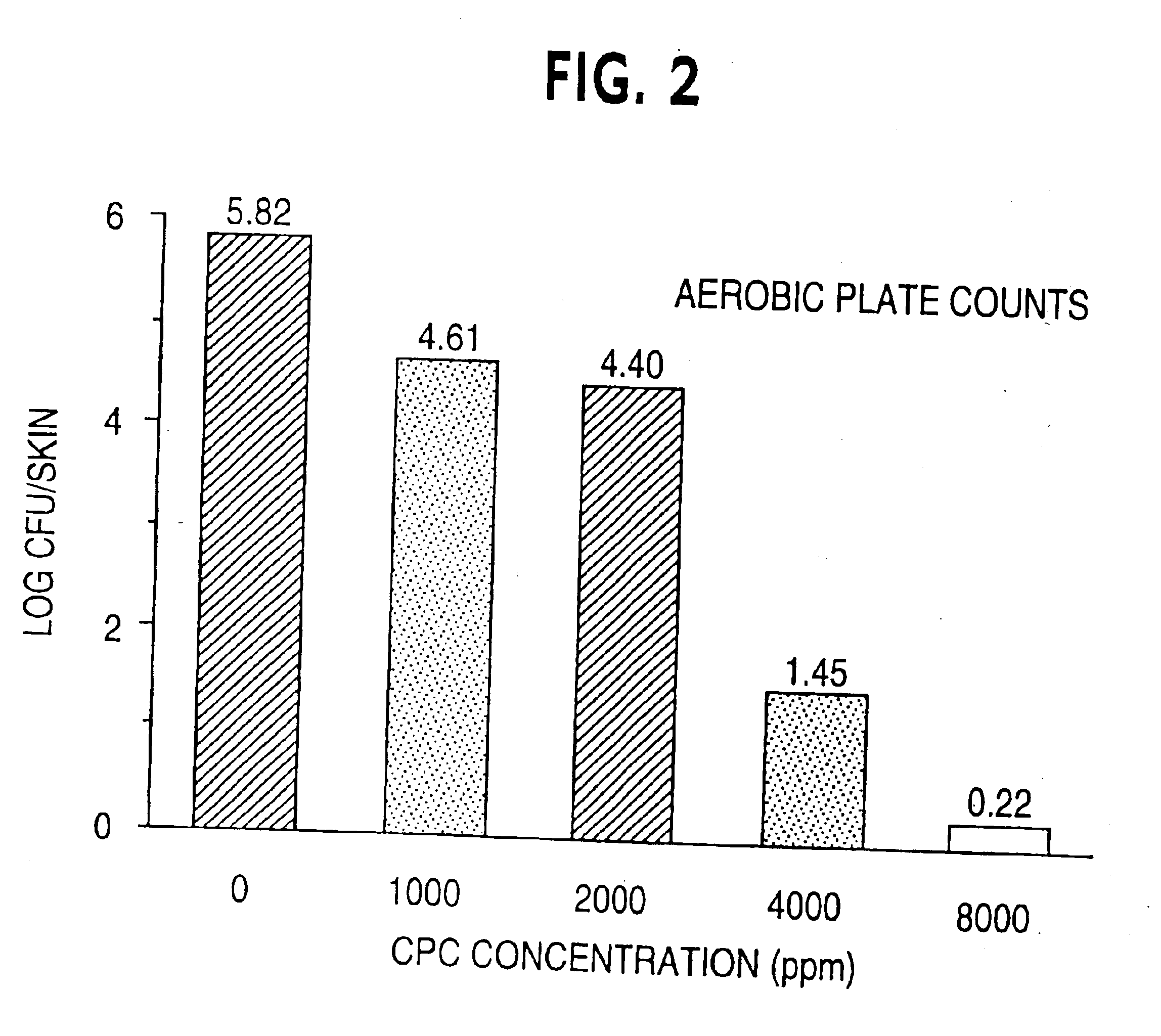Concentrated, non-foaming solution of quarternary ammonium compounds and methods of use
a technology of concentrated ammonium compounds and non-foaming solutions, which is applied in the field of concentrated ammonium compound non-foaming solutions and methods of use, can solve the problems of foodborne microbial contamination, poultry and meat processors have encountered major difficulties in removing microorganisms, and cannot be rubbed off, so as to prevent the growth of a broad spectrum of pathogenic bacteria, prevent the growth of a broad spectrum of microorganisms, and facilitate dil
- Summary
- Abstract
- Description
- Claims
- Application Information
AI Technical Summary
Benefits of technology
Problems solved by technology
Method used
Image
Examples
example 1
Bactericidal Activity of Quaternary Ammonium Compounds in Suspension Cultures (Not Attached to Meat Products)
Minimum Inhibitory Concentration (MIC) of Quaternary Ammonium Compounds
[0067]Minimum inhibitory concentrations (MIC) for QAC were determined in Mueller Hinton broth (BBL Microbiology System) using the macrodilution method established by the 1987 National Committee for Clinical Laboratory Standards. Experiments were conducted by 16 hour incubation at 37° C. for Staphylococcus aureus, Escherichia coli O157:H7, Listeria monocytogenes, and Salmonella typhimurium. For Aeromonas hydrophila, and Bacillus cereus incubations were performed at 30° C. MIC were determined by the lowest dilution with no visible turbidity. Table 2 shows the data from the above experiment:
TABLE 2MINIMAL INHIBITORY CONCENTRATION (MIC)Cetylpyridi-niumCPCchloride,vsCPCCPCCPCCPCCPC vs(CPC)E. coliVsVsVsVsL. monocyt-μg / mLO157:H7B. cereusS. aureusS. typhimuriumA. hydrophilaogenes125−−−−−−62.5−−−−−−31.25−−−++−15.63...
example 2
Effects of Quaternary Ammonium Compounds on the Reduction of Viable Bacteria Attached to Chicken Skin
[0072]Chicken skins (2.5×2.5 cm) excised from a drumstick, sterilized by a 45 KGy dose of irradiation from an electron source, were placed epidermal side up in each well of six-well tissue culture plate. Each skin piece was inoculated with 5 ml 0.008 M phosphate buffered saline (PBS, pH 7.2) containing 6-8×103 CFU / ml bacteria with the exception of the background control group that was treated only with 5 ml of PBS. The plates were incubated (30 min, 35° C.), and each skin piece was rinsed (2×, 5 ml PBS) to remove loosely bound (unattached) microorganisms. Each inoculated skin was treated with 5 ml of PBS containing CPC. Three pieces of skin were used for each concentration of CPC, including one in which the skins were treated only with 5 ml of PBS (0 concentration). The plates were incubated with shaking (100 rpm) for 30 min at 25° C. After incubation, each skin piece was rinsed (5 m...
example 3
Effects of Quaternary Ammonium Compounds on the Inhibition of Bacterial Attachment to Chicken Skin
[0074]Chicken skins (2.5×2.5 cm) excised from a drumstick, sterilized by a 45 KGy dose of irradiation from an electron source, were placed epidermal side up in each well of six-well tissue culture plate. Each skin piece was inoculated with 5 ml 0.008 M phosphate buffered saline (PBS, pH 7.2) containing CPC. Three pieces of skin were used for each concentration of test compound, including one in which the skins were treated only with 5 ml of PBS (0 concentration). The plates were incubated with shaking (100 rpm) for various times (1 min or 10 min) at 25° C. The incubating solution was removed by aspiration, and the skins were rinsed (5 ml PBS), and then incubated 30 min, 35° C. with 5 ml of PBS containing 6-8×103CFU / ml bacteria. After incubation, each skin piece was rinsed (2×, 5 ml PBS), to remove loosely bound (unattached) microorganisms, placed in a sterile plastic bag containing 80 m...
PUM
| Property | Measurement | Unit |
|---|---|---|
| Percent by mass | aaaaa | aaaaa |
| Percent by mass | aaaaa | aaaaa |
| Percent by mass | aaaaa | aaaaa |
Abstract
Description
Claims
Application Information
 Login to View More
Login to View More - R&D
- Intellectual Property
- Life Sciences
- Materials
- Tech Scout
- Unparalleled Data Quality
- Higher Quality Content
- 60% Fewer Hallucinations
Browse by: Latest US Patents, China's latest patents, Technical Efficacy Thesaurus, Application Domain, Technology Topic, Popular Technical Reports.
© 2025 PatSnap. All rights reserved.Legal|Privacy policy|Modern Slavery Act Transparency Statement|Sitemap|About US| Contact US: help@patsnap.com



